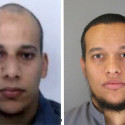The two French brothers wanted in the newspaper office bloodbath in Paris were already known to U.S. authorities and had been put on the American no-fly list. Another U.S. official said the older brother, Said Kouachi, had traveled to Yemen. It was unclear whether he was there to join up with extremist groups such as al-Qaida.
The details emerged as French authorities conducted an all-out manhunt for the Kouachi brothers — Cherif, 32, and Said, 34 — in the terror attack Wednesday that killed 12 people at the offices of Charlie Hebdo, a weekly that lampooned radical Islam and the Prophet Muhammad.
They were identified as suspects after the older brother’s ID card was found in the getaway car, authorities said.
Witnesses said the gunmen in the attack claimed allegiance to al-Qaida’s offshoot in Yemen.
Both Kouachi brothers — the Paris-born offspring of Algerian parents — were already known to French counterterrorism authorities.
Cherif, a former pizza deliveryman, had appeared in a 2005 French TV documentary on Islamic extremism and was sentenced to 18 months in prison in 2008 for trying to join up with fighters battling in Iraq.
The U.S. no-fly list includes known or suspected terrorists and extremists.
The U.S. officials spoke on condition of anonymity because they were not authorized to discuss foreign intelligence publicly.
A French security official, speaking on condition of anonymity because of the sensitivity of the matter, said that American authorities had shared intelligence with France indicating that Said had traveled to Yemen several years ago for training. French authorities were seeking to verify the information, the official said.
Cherif Kouachi chased girls and belted out rap lyrics in his rough-and-tumble Paris neighborhood before the words of a firebrand Muslim preacher persuaded him to book a flight to Syria to wage holy war.
The cleric “told me that (holy) texts prove the benefits of suicide attacks,” Kouachi was quoted as saying in the TV documentary. “It’s written in the texts that it’s good to die as a martyr.”
Associated Press reporters who covered his 2008 trial, which exposed a recruiting pipeline for Muslim holy war in the multi-ethnic and working-class 19th arrondissement of Paris, recalled a skinny young defendant who appeared very nervous in court.
Cherif Kouachi’s lawyer said at the time that his client had fallen in with the wrong crowd.
During the trial, Kouachi was said to have undergone only minimal training for combat — going jogging in a Paris park to shape up and learning how a Kalashnikov automatic rifle works by studying a sketch.
He was described at the time as a reluctant holy warrior, relieved to have been stopped by French counterespionage officials from taking a Syria-bound flight that was ultimately supposed to lead him to the battlefields of Iraq.
French Interior Minister Bernard Cazeneuve, however, said Thursday that Kouachi had been described by fellow would-be jihadis at the time as “violently anti-Semitic.”
Imprisonment changed him, his former attorney Vincent Ollivier told Le Parisien newspaper in a story published Thursday.
Kouachi became closed off and unresponsive and started growing a beard, the lawyer said, adding that he wondered whether the stint behind bars transformed his client into a ticking time bomb.
There was a time, though, when he had very different interests.
Footage in the documentary, part of a prestigious French public television series titled “Evidence for the Prosecution,” shows him in 2004, when, according to the narrator, the lanky young man in a black T-shirt with extremely close-cropped hair and a chunky wristwatch was keener on spending time with pretty girls than on going to the mosque. He appears relaxed and smiling as he pals around with friends.
At one point, with his baseball cap worn backward, Kouachi belts out some rap music and breaks into a joyful dance.
After he got out of prison, police detained him again in 2010 in an investigation of an alleged plot to free an Islamic militant sentenced to life in prison for bombing a Paris train line. Kouachi was ultimately released with no charges ever brought.
Much less has become public about Said, but Cazeneuve said the jobless resident of the city of Reims was also known to authorities, despite having never been prosecuted, because he was “on the periphery” of his brother’s illegal activities.
In Reims, about 90 miles (145 kilometers) northeast of Paris, Said frequented a prayer room on the ground floor of an apartment building, according to the local imam, Abdul-Hamid al-Khalifa.
Al-Khalifa told the AP that Said wore traditional North Africa clothes to prayers and didn’t mix much — if at all — with other worshippers.
“Typically, he’d come late to prayers and leave right when they were done,” Al-Khalifa said in a telephone interview.
If French authorities are now hunting for the right suspects, it may be because of Said, Cazeneuve hinted.
In the stolen Citroen abandoned Wednesday by the gunmen, police found a French identity card in the older Kouachi’s name, the minister said.
Moreover, after the attackers dumped the first car, they grabbed another, and Cazeneuve said the elder Kouachi had been identified as “the aggressor” by witnesses shown his photo.
A third suspect identified by French authorities in the attack turned himself in Wednesday night. Mourad Hamyd, 18, surrendered at a police station after learning his name had been linked to the case in the news, said Agnes Thibault-Lecuivre, spokeswoman for the Paris prosecutor.
She did not specify his relationship to the Kouachis.

